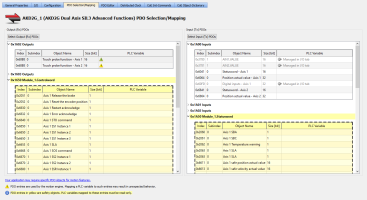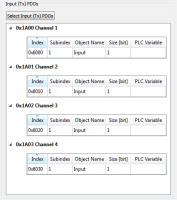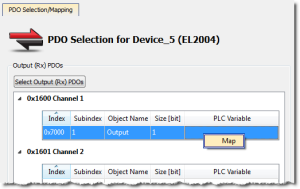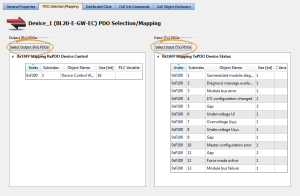PDO Selection/Mapping Tab
This tab includes the PDO![]() PDO is a type of protocol frame used in some fieldbuses. A PDO contains one or more object dictionary entries, which define the application data transferred between devices. configurations for an EtherCAT
PDO is a type of protocol frame used in some fieldbuses. A PDO contains one or more object dictionary entries, which define the application data transferred between devices. configurations for an EtherCAT![]() ***EtherCAT is an open, high-performance Ethernet-based fieldbus system. The development goal of EtherCAT was to apply Ethernet to automation applications which require short data update times (also called cycle times) with low communication jitter (for synchronization purposes) and low hardware costs device. Assigned PDOs and their objects are viewable for the Inputs (Tx) and Outputs (Rx). The PDOs become active when the EtherCAT network is initialized to operation mode.
***EtherCAT is an open, high-performance Ethernet-based fieldbus system. The development goal of EtherCAT was to apply Ethernet to automation applications which require short data update times (also called cycle times) with low communication jitter (for synchronization purposes) and low hardware costs device. Assigned PDOs and their objects are viewable for the Inputs (Tx) and Outputs (Rx). The PDOs become active when the EtherCAT network is initialized to operation mode.
Figure 4-114: The PDO Selection/Mapping tab including FSoE objects in yellow.
-
-
- Safety PDOs are highlighted in yellow with a border.
- Any variable assigned to a FSoE PDO must be Read Only. See About Safety, PDOs, and Variables for more information.
- See How To Set Up a Variable to Monitor Safety Data for step-by-step instructions.
Each assigned PDO is listed by its Index (hex) and Name. The objects associated with each PDO are listed below the name. The objects are identified by their object dictionary Index and Subindex. The Object Name provides a simple description. The Size determines the data length. The PLC Variable mapped to the PDO objects is also listed.
Map PLC Variable to PDO Object
PLC![]() "Programmable Logic Controller"
A Programmable Logic Controller, PLC, or Programmable Controller is a digital computer used for automation of industrial processes, such as control of machinery on factory assembly lines.
Used to synchronize the flow of inputs from (physical) sensors and events with the flow of outputs to actuators and events variables can be mapped to PDO objects by:
"Programmable Logic Controller"
A Programmable Logic Controller, PLC, or Programmable Controller is a digital computer used for automation of industrial processes, such as control of machinery on factory assembly lines.
Used to synchronize the flow of inputs from (physical) sensors and events with the flow of outputs to actuators and events variables can be mapped to PDO objects by:
- Double-clicking in a PLC variable cell to open the PLC Variable Selector.
- Right-clicking in a PLC variable cell and select Map or Unmap.
- Drag-and-drop a variable from the Dictionary to a PLC variable cell.
- Multiple objects may be selected by:
- Shift-clicking a contiguous range of objects.
- Ctrl-clicking non-contiguous objects.
- Do not map PLC variables to third-party drive PDO objects.They may conflict with the KAS Runtime
 In computer science, runtime (or run-time) describes the operation of a computer program, the duration of its execution, from beginning to termination (compare compile time).
Within KAS, runtime also refers to the virtual machine that manage the program written in a computer language while it is running's internal motion engine read/write operations.
In computer science, runtime (or run-time) describes the operation of a computer program, the duration of its execution, from beginning to termination (compare compile time).
Within KAS, runtime also refers to the virtual machine that manage the program written in a computer language while it is running's internal motion engine read/write operations.
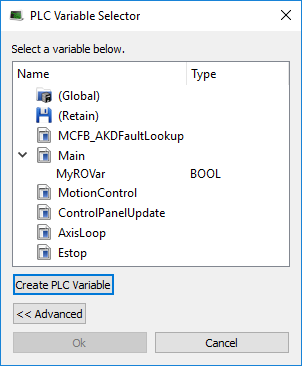
PLC variables may be mapped to safety objects in exactly the same way as any other object, but the variable must be set as Read Only.
- The PLC Variable Selector will display only Read Only variables.
- Variables created by clicking the Create PLC Variable button, when accessed from a safety PDO, will automatically be set to Read Only.
- There will be no warning if an assigned variable is changed to Read/Write, but an error will be reported when the project is compiled.
When an device is removed using ECATDeviceAction, what happens to variables depends on what they are mapped to.
- Variable mapped to an Input (Tx) PDO object: The value of the variable becomes '0' when the mapped device is removed. The device PDO object will be automatically reconnected to the variable when the device is reconnected to the network.
- Variable mapped to an Output (Rx) object: The link to the device PDO is removed when the mapped device is removed. When the device is reconnected, the PDO object will be automatically reconnected to the variable.
For more details, please see Map Input and Output to Variables.
Select Input and Output PDOs
Press the Select Input (Tx) PDOs or Select Output (Rx) PDOs button to choose the Input or Output PDOs. The appropriate dialog box will open.
- The upper portion contains checkboxes to select specific PDOs for the EtherCAT network cyclic data.
- The lower portion contains the list of object(s) included within a specific PDO.
Viewing the contents of a PDO
Click on a row in the upper portion of the PDO Selector dialog box to view the contents of that PDO. The lower portion will update to list the associated objects. Using the following example, the PDOs 0x1A02 and 0x1A03 are selected for the input objects but the contents for PDO 0x1A00 are listed because that row is selected..

|
|
-
-
- Some EtherCAT devices may not have selectable input and/or output PDOs.
- Some PDOs allow you to select more than one PDO at a time while others are exclusive.
- Exclusive PDOs prevent simultaneously selecting certain other PDOs. Using the following image as an example, choosing PDO 0x1A00 excludes selecting PDO 0x1A04.
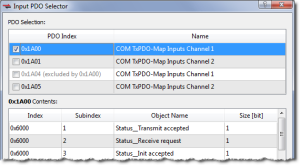
- Device vendors determine the PDO(s), content and possible selection exclusivity. This information is defined inside the device vendor's ESI file. Please contact the device vendor for details about a specific device.
